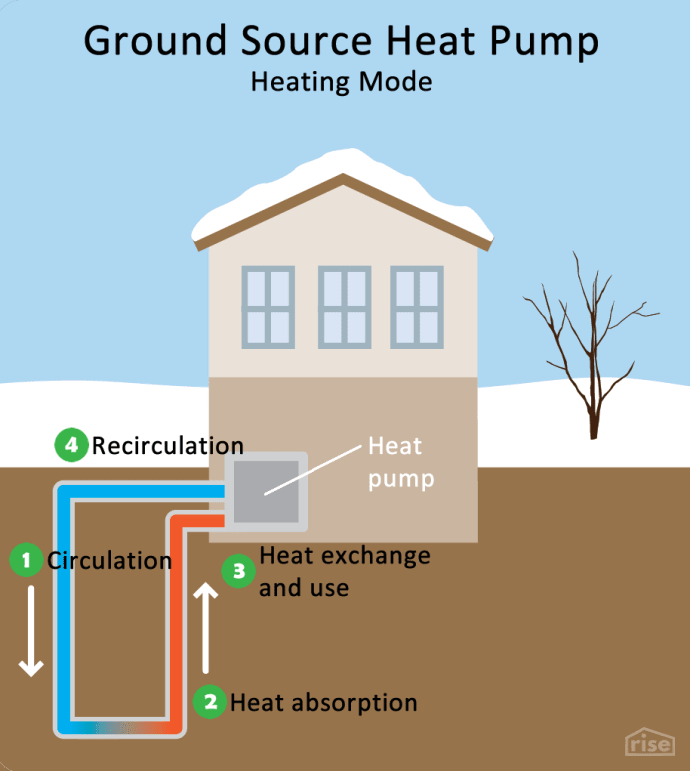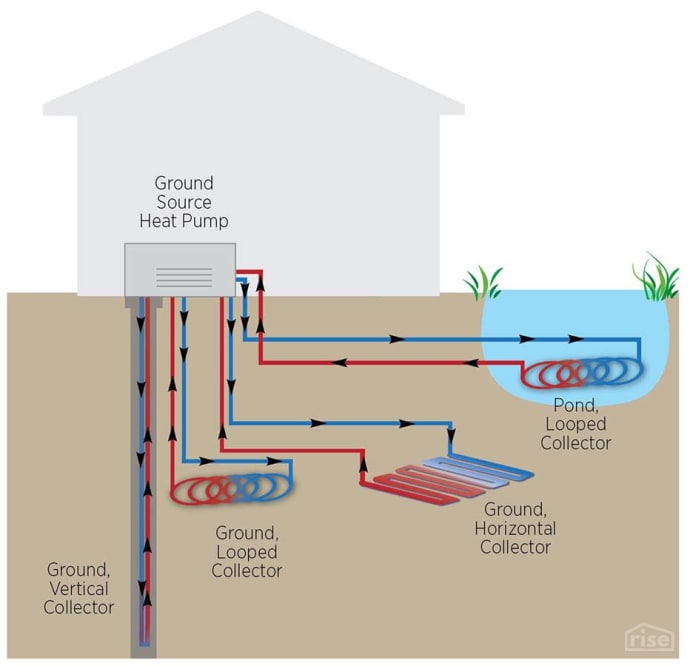
Geothermal Heating Guide: Costs and Benefits
Wondering what the costs and benefits might be for a sustainable way to heat and cool your home? Let’s take a look at the financial payback and other benefits of a geothermal heat pump.
Table of Contents
- What Is a Geothermal Heat Pump?
- How Does Geothermal Work?
- How Deep Do Geothermal Pipes Need to Be?
- Is Geothermal a Sustainable Heating Source?
- Does Geothermal Increase the Value of a Home?
- Does Geothermal Produce Electricity?
- How are Geothermal Pipes Buried?
- What Is the Lifespan of Geothermal?
- How Much Does a Geothermal Cost?
- The Cost of Geothermal vs. Fossil Fuels
- How Much Can You Save With Geothermal?
- What's The Payback Period of Geothermal?
- How To Finance a Geothermal Heat Pump,Bottom Line on Geothermal
What Is a Geothermal Heat Pump?
A geothermal heat pump, also known as a ground-source heat pump, offers a clean, reliable, and super-efficient supply of heat and air conditioning. Geothermal heat pumps take the naturally occurring, constant temperature of the earth to heat and cool your home. Although slightly varying depending on latitude, the temperature just below the earth's surface remains between 45-75 °F. The relative heat and cooling from the earth can naturally bring the air inside your home to your desired home temperature, which is usually between 68-72 degrees. In the winter, when the ground temperature is warmer than the outside air temperature, the heat pump will move heat from the ground into your home to help you reach that desired temperature. In the summer, when the ground temperature is cooler than the outside air, you can transfer the heat inside your home into the ground, which will act as a "heat sink."

How Does Geothermal Work?
Geothermal systems require drilling or digging holes to install pipes either vertically or horizontally in the ground. Thus, it is necessary to have enough access to space and proper geology (i.e., deep soil vs. bedrock). Ponds can offer solutions to access areas and suitable geology issues. However, they require a significant body of water and may require environmental permits. A heat pump moves water or some other fluid—often a mix of water and glycol—through the underground pipes where it is naturally warmed or cooled. The liquid is the vehicle that absorbs heat either inside your home or underground and transfers it accordingly. In heating your home with warm air, the fluid transfers its retained heat to your home's existing air handling, distribution, and ventilation system. If your home is heated with radiant heat using water running through pipes, it's a direct transfer.
How Deep Do Geothermal Pipes Need to Be?
The temperature beneath the earth´s surface remains constant year-round. Once you get beneath the frost line, if your region has one, the temperature of the earth remains a constant 50 to 60 degrees Fahrenheit depending on where you are. That means that when it´s 100 degrees outside, the temperature is a comfortable 60 degrees only 3 to 4 feet underneath your feet. Similarly, when it´s 0 degrees outside in the middle of winter, comfortably warm 55-degree air is circulating underneath your home.

Is Geothermal a Sustainable Heating Source?
Geothermal heat pumps are considered an exceptionally efficient heating and cooling system for your home. While geothermal heating and cooling systems do need a pump that will move the water through the underground pipes and into your home (like a traditional boiler system), the pump system only use one unit of electricity for every five units of heating or cooling moved from the earth into your home. If you want your system to become completely sustainable, you can look into purchasing a solar-powered pump.
If your electricity is fueled by an energy company using gas or coal, there may still be a carbon impact with its use. Geothermal heat pumps offer 45 percent greater efficiency, however, and electricity is becoming cleaner with renewable energy technologies. So, your carbon footprint from geothermal heat pumps will be significantly lower than with other standard systems.
Does Geothermal Increase the Value of a Home?
A geothermal heating system is likely to increase the value of your home. When passing on geothermal heat pump savings to a new home buyer, they are likely to be more willing to pay a higher upfront cost.
Does Geothermal Produce Electricity?
A common misconception related to geothermal heating and cooling systems is that they are confused with geothermal energy. Geothermal energy plants utilize the hot air from magma, lava, and other volcanic-like forces to produce electricity. In contrast, geothermal heating and cooling units don't produce energy but rather heat and cool your home with the earth's constant underground temperature.
How are Geothermal Pipes Buried?
Depending on your soil type, polyethylene plastic pipes can be buried either vertically or horizontally at a minimum depth of 4 to 6 feet. Another option is to bury pipes in a pond system where the water insulates the coiled pipes. Thus, you can theoretically combine your geothermal heating and cooling system with a landscaping pond that adds beauty to your property.
What Is the Lifespan of Geothermal?
A geothermal heat pump has a lifespan of 20-25 years and 25-50 years for the underground infrastructure. You can also expect minimum maintenance costs.
How Much Does a Geothermal Cost?
Geothermal heat pumps typically have an upfront cost of between $20,000-$80,000 installed. This price includes all the new equipment, professional excavation, and installation of the system. The broad price range incorporates:
- Variance in excavation costs (hence the importance of surveying your surrounding geology)
- Your home's square footage requiring a system sizable enough to heat the space adequately.
- The type of system installed (horizontal installation is usually less expensive)
The Cost of Geothermal vs. Fossil Fuels
The cost of fossil fuels is likely to continue to rise. The climbing cost will gradually increase your utility bill's cost if you currently rely on gas or oil for heating and cooling purposes. On the other hand, Geothermal only requires electricity (which can easily be renewable) and the earth's natural warming and cooling properties.

How Much Can You Save With Geothermal?
ENERGY STAR certified geothermal heat pumps are 45 percent more efficient at heating and cooling your home than standard systems. Meaning, your utility bill that accounts for heating and cooling your home will be reduced by 45 percent with an ENERGY STAR certified geothermal heat pump.
Heating and cooling usually account for the highest proportion of energy use in your home, so this is the area greatest impacted by energy savings. The U.S. Energy Information Association (EIA) last reported that, on average, 51 percent of a household's energy consumption is for heating and cooling. A 45 percent reduction from greater efficiencies, applied to that 51 percent of your utility bill, will effectively reduce your total utility bill by 28 percent.
In real savings, if your utility bills are $5,000 per year, they will go down to about $3,600, saving about $1,400 per year.
What's The Payback Period of Geothermal?
For a geothermal heat pump with a raw upfront cost of $20,000, a 30% tax credit would bring the initial cost to $14,000. With energy savings of $1,400 a year, the system will pay for itself in 10 years.
The payback is all relative to your home's size, the type of system installed, the kind of system replaced, and your consumption and cost of electricity of fuel. The typical payback is usually around 8-10 years since most of these factors are corresponding. For instance, the bigger your home, the more energy consumption used for heating and cooling, and the larger the system required.
How To Finance a Geothermal Heat Pump
There are several possible ways to lower this upfront cost significantly, reducing it to a level more comparable to a traditional whole-house heating and cooling system. You can find all available rebates and incentives for renewables and efficiencies filtered in the U.S. by state here. Enter your zip code, then click "apply filters" on the right. Choose technology, renewable energy, geothermal technologies, geothermal heat pumps, then apply filters. For Canada and the U.S., you can access Rise's database of incentives.
The U.S. currently offers a 22% to 26% Renewable Energy Tax Credit for renewable energy systems, including geothermal heat pumps. The credit declines each year, and systems must be in place on or before January 1, 2022. The tax credit applies to geothermal systems installed in your first home or second home. Many energy companies offer further rebates for geothermal heat pumps. Contact your local energy company to get more savings on upfront costs! Another option to decrease upfront costs is to lease a geothermal heat pump.
Bottom Line on Geothermal
Geothermal heat pumps pay for themselves through energy savings in about ten years and become closer in price to standard heating and cooling systems through tax credits and rebates. If you plan on staying in your home for as long or longer, they are a great option. Also, if you sell your home before the payback is finalized, it is reasonable to value your home higher accordingly. Geothermal heat pumps have a long life, are highly reliable, and require very little, simple maintenance. Especially if your house requires substantial heating and cooling, a geothermal heat pump offers a highly efficient, sustainable energy option.
Disclaimer: This article does not constitute a product endorsement however Rise does reserve the right to recommend relevant products based on the articles content to provide a more comprehensive experience for the reader.Last Modified: 2021-08-17T20:28:52+0000Article by:
Samantha Aimone
Samantha Aimone is a student at Fordham University pursuing a Bachelor of Science in Business Administration with dual concentrations in finance and social innovation. Samantha is a change maker and she is driven to help businesses attain sustainability through disruptive innovation.